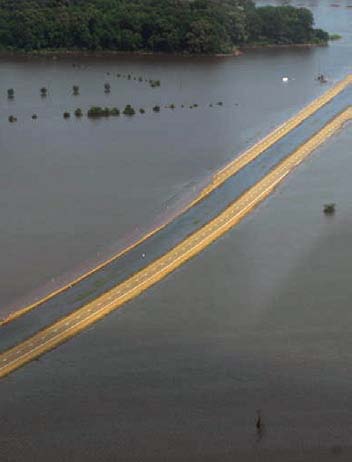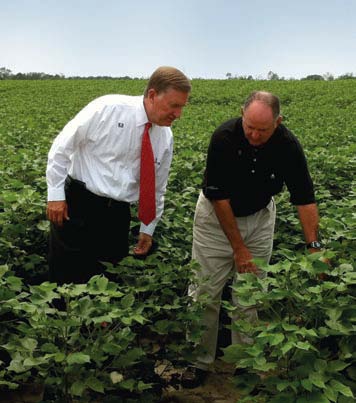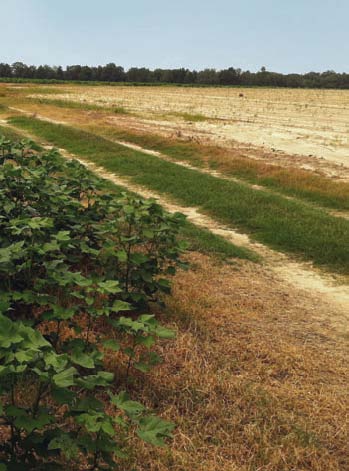It seems when you talk to any one of the Staplcotn directors who have witnessed the extreme weather problems this year, whether they are from the Mid-South or the Southeast, the response is the basically the same, “I’ve never seen anything like this is all my years of farming”.
The spring of 2011 brought floods to many areas of the Mid-South, some of which were followed by severe wind and sand storms. On the other end of the spectrum, much of the Southeast has battled drought conditions which have left many of these seasoned cotton producers desperate for an extended fall.
Johnny Hux, director from Sikeston, Missouri, explained how his area was affected by the floods in early May. “We are in the part of Missouri–Mississippi County–where the decision was made to blow the Birds Point Levee to ease the pressure of the water flowing into the Mississippi River. That obviously flooded all of the lower level farm land which was mainly bean and corn ground. Then, we had 28 1/2” of rain which flooded the west side. That\ was cotton ground and it wasn’t able to drain very quickly because the ditches couldn’t handle more water. Most of the cotton crops had to start late as a result. East of here, some of the farms had ground that eroded too much and they couldn’t plant. Further west, some farmers got a crop in but had to change plans because after the flooding, we had a drought. We’ve had farmers that had to replant a couple of times and the weeds have been like you wouldn’t believe. Lately we’ve had a few showers, though. It looks like we should make a good crop IF we don’t get an early frost. We’ve had to do a lot of irrigation though, and without that we would be ‘up a creek’. Many around here are just hoping to break even.”
Like Hux’s area of Missouri, Staplcotn Director Lowry Robinson’s area around Osceola, Arkansas, experienced flooding both from the river itself and the “dry” side of their levees with the standing water due to heavy rains. But, after that subsided, they were faced with horrendous wind and sand storms for over a month that wiped out whole stands of cotton. Robinson explained, “Farmers in the area found themselves planting two or three times and some finally ran out of calendar. Some of the cotton acreage went to beans for that reason. Had we not had such severe weather in northeast Arkansas, we would probably be seeing 10-15% more cotton here. The amount of cotton acreage lost would have been even higher had some of the farmers not called their cotton already. They did whatever it took to get cotton in the ground and pushed their calendars a little further. Things are looking better now around here, though. It will still be a late crop and we will need a nice fall to have a reasonable yield. It’s about as strange a year as I have ever seen.” Robinson’s area has also experienced significant weed problems. “I’ve haven’t seen this many people chopping cotton in the fields in years,” he said.
Staplcotn Director Bowen Flowers said his area around Clarksdale, Mississippi, was fortunate in that it avoided the flood water problems but it wasn’t so lucky with the wind and sand storms. “Mid-May, after most had finished planting, we witnessed serious wind storms and sand storms that wiped out the sandy land cotton and many had to replant. Now, we are about three weeks late. In some of the areas around here, farmers had to replant about a third of their total acreage. The sand storm was so severe, that in some spots in Tunica County, they had to get a road grater to get the sand off the road.”
Although Mother Nature dealt a polar opposite hand to many in the Southeast, the challenges they’ve faced have been quite similar. Mike Newberry, Staplcotn Director from Arlington, Georgia, reported that his area has had complications from the drought since the onset of planting season. “From this area and south, many of the fields are irrigated with a Floridian aquifer which is usually recharged in the wintertime with the rains we normally get. We went into this season without our normal underground supply of water–only about half of what we normally have–and the daily temperature has averaged three degrees higher than normal. So it was hard to get the crops in the ground, hard to get them to make a stand. Many area farmers with dry land crops have had to plant two or three times and some of those farms have been harrowed up. We have several more weeks to keep water on the irrigated crops but some of the wells went dry about a month ago. In the last three weeks, Southwest Georgia has seen some pretty good rainfall, but the dry land crop is late so they need an extended warm fall to make the crop here. We need at least four extra weeks and we sure don’t need a frost between now and Christmas!”
Allen Whitehead, Staplcotn Director from Ashburn, Georgia, had a similar report. “Many farmers in this area had to water two or three times just to try to get the cotton in the ground. Then, they had to plant two or three times to make a stand. One farmer replanted five times and still didn’t have a stand. Many of the smaller farms have had to be abandoned and thousands of acres around here have been harrowed up. On some of the crops that have been irrigated with center pivots, you can look in the corners and see nothing, not even weeds. In the fields, though, the weeds and bugs have been extremely difficult to deal with. Because of the height differential, some have either not been able to use herbicides or they’ve seen a significant resistance to the herbicides. Farmers around here have had to do more hand weeding than they’ve ever done. The input costs on this year’s crop have increased tremendously–more irrigation, more fuel costs, and higher herbicide costs.I’ve talked to some people around here who have said they’ve had planters out this year longer than any other time in their farming careers. This is my 32nd or 33rd crop and I’ve never seen it this way,” said Whitehead.
George LaCour, Staplcotn Director from Morganza, Louisiana, explained that his area has been affected by both extremes– record setting floods AND a record setting drought all in the same year. “Half the parish has been under water and the other half is burning up,” he said. “Out of the 280,000 acres of cotton in Louisiana, 10% was affected by the water, but 90% is affected by the drought. The non-irrigated cotton looks awful and rains continue to be sporadic here. There’s only been maybe an inch of rain here since April. Some folks affected by the flood were able to replant, but some of the land never got a crop on it. The mood of the people this year though, is much better than you would expect. At least this year, the insurance will cover their costs because it was figured at around $1.30 per pound which helps the anxiety level. We couldn’t wait for this year to start and now, we can’t wait for this year to end. But the general attitude is that we’ll be back. We’ll try it again next year.”
Even with all of the challenges and adversities brought on by this history making spring weather, it appears that there could be a rainbow ahead. Most of those who have “weathered the storm” are now experiencing good growing conditions for the late planted crops. If these conditions continue until harvest season, and they get a little extra help from Mother Nature with a delayed frost, they should be able to realize the true potential of this 2011 crop.





